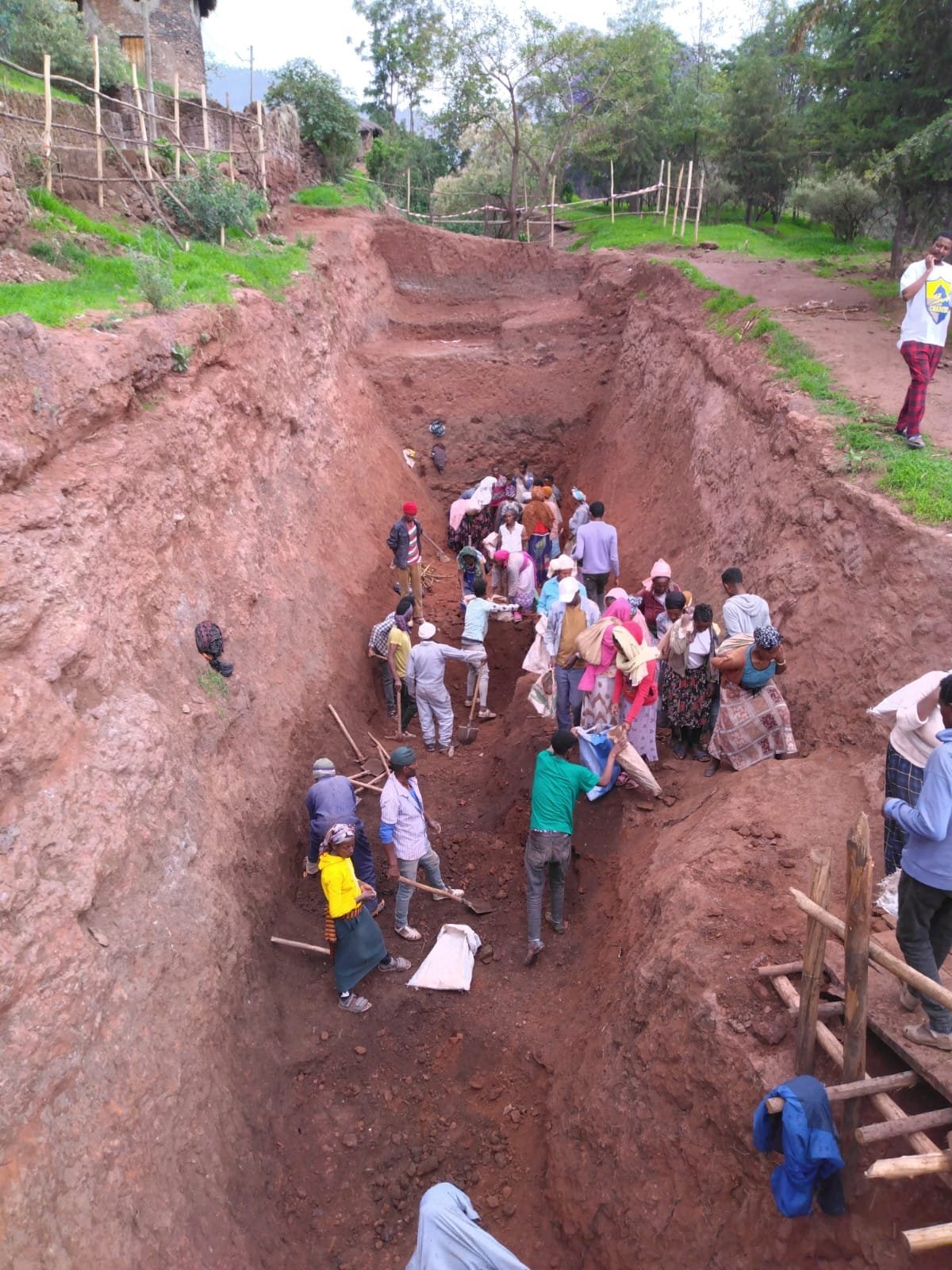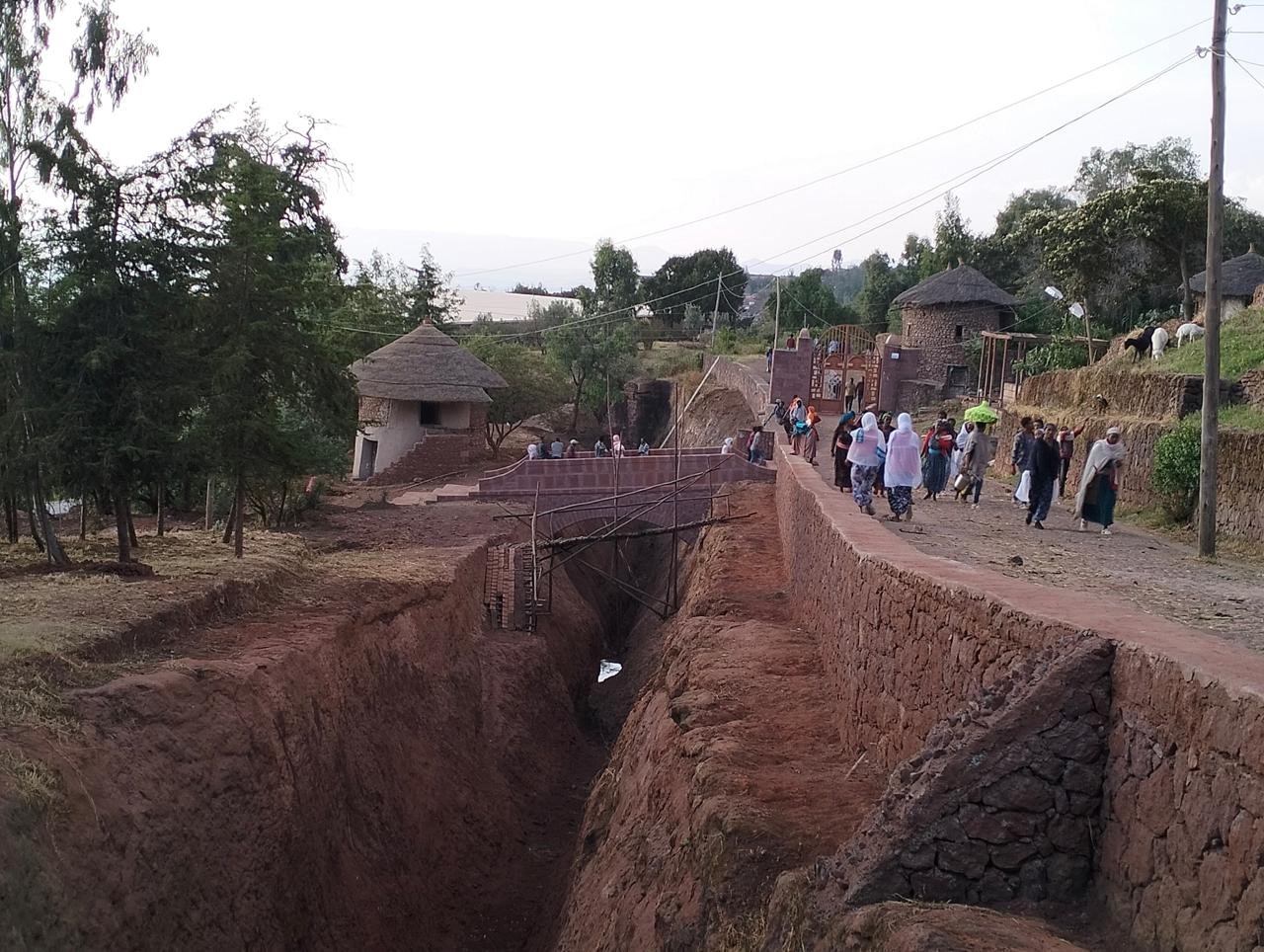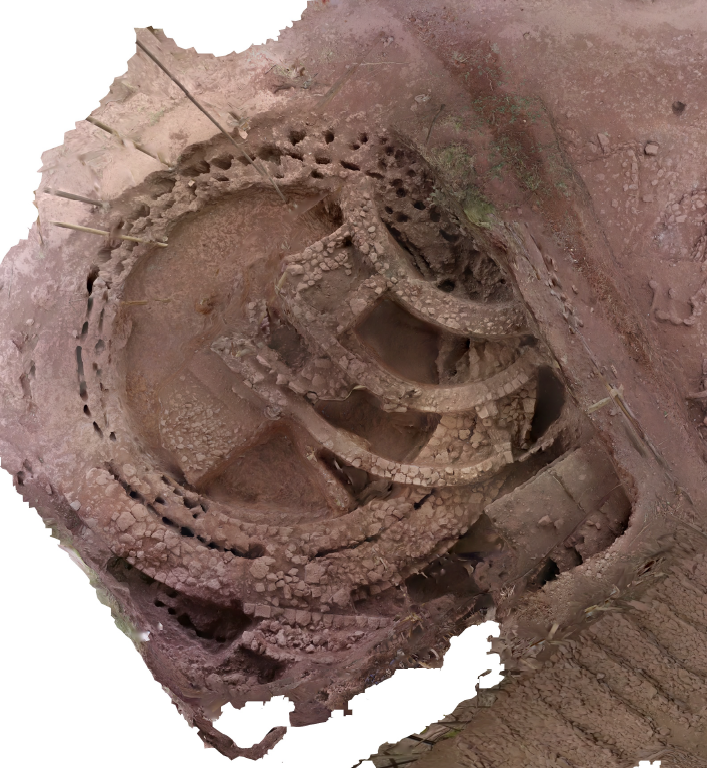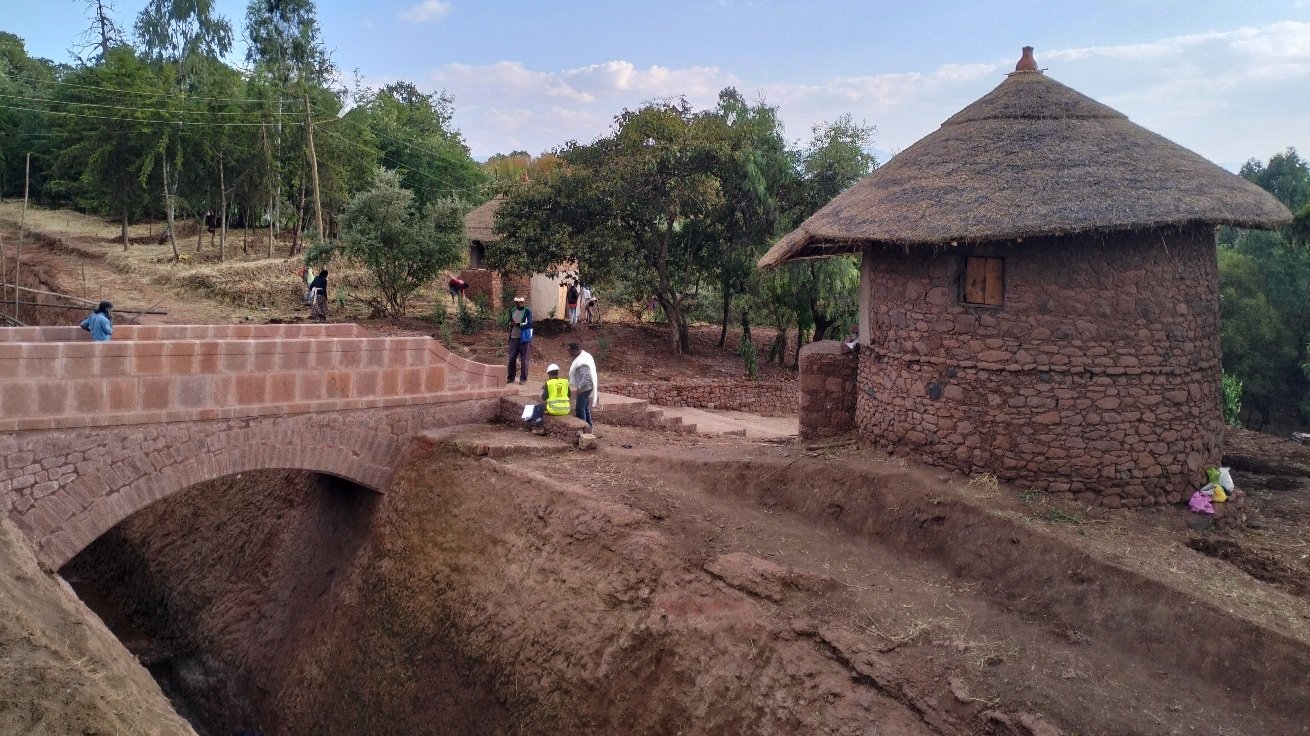
The Adish Adie Bridge
At the summit of Lalibela's churches, on the path that runs alongside the two groups of monuments on one side and the old Adish Adie neighborhood on the other, a new stone bridge has just been erected. Its construction became necessary when one of the monumental trenches on the site was emptied, cutting off one of the accesses between the upper and lower parts of the city. The excavation of this trench is part of an archaeological and landscape program aimed at restoring the system of trenches formerly dug on the site to better understand their functions. These works were conducted under the supervision of an archaeological team, and the results will be detailed in an upcoming bulletin.
When this project began in 2020, CNRS provided for emergency conservation and enhancement works at the Lalibela site, both a stone cutter – Antoine Garric – and a heritage management specialist – Kidane Ayalew, a knowledgeable figure of the site. Based on criteria prepared by Kidane Ayalew, 19 artisans (stonecutters, masons, and carpenters) were selected by the local committee for the conservation of Lalibela's heritage. Antoine Garric took charge of training them, among other things, in the creation of stone structures, and together they undertook the construction of several bridges. Kidane Ayalew, on his part, organized the works and their logistics on the site, managed the teams, and ensured daily coordination with civil and religious authorities in Lalibela and Addis Ababa.
After two years of training programs, the team of artisans embarked on the construction of the Adish Adie bridge, autonomously.
Constructed entirely of cut stones and rubble from Lalibela quarries, the new Adish Adie bridge forms a self-supporting arch, embedded in the rock, spanning the trench with its bottom approximately 6 meters below. Elegant parapets secure the bridge while providing points of support for strollers who want to admire the view. The newly emptied trench, the bridge, and the completely restored surrounding tukuls blend seamlessly into the landscape of the site, restoring some of its splendor.
Moreover, the Adish Adie bridge is the result of the work of about thirty artisans from the city, a team gradually formed as part of the Sustainable Lalibela project.
This autonomy was partly constrained by the deteriorating security conditions in Lalibela, preventing Antoine Garric and Kidane Ayalew from traveling to Lalibela for the construction of the Adish Adie bridge. In August 2023, the outskirts of the city witnessed violent clashes between the Ethiopian army and the fanos, armed groups fighting in defense of the Amharas. Quickly placed under the control of the Ethiopian army, Lalibela has since been marked by strong tensions, weighing primarily on the local communities, up to the tragic events of November, which saw combat unfold in the heart of the city and in the immediate vicinity of the churches.
Since August 2023, the artisans have continued their work and completed the construction of the Adish Adie bridge, with guidance provided over the phone by the team based at the French Center for Ethiopian Studies in Addis Ababa. Technical advice, validation of stages, financial and logistical support – all were accomplished over the phone. When they managed to gather a bit of internet connection, Ambachew Tegen and Sisay Mekoya, the supervisors of the artisans' team in Lalibela, reported on the work progress, sent photos, or requested plans and technical advice.
The Adish Adie bridge is both the story of the local appropriation of a heritage and scientific cooperation project and the tale of resilience of a small group of Lalibela artisans.

The Adish Adie Trench
Adish Adie is the name of one of the old, central, and iconic neighborhoods of Lalibela. Before its destruction in the 2010s as part of a tourism development support program funded by the World Bank, it stretched immediately to the east of the two main groups of churches. The paths were narrow and winding, accessible only by foot. Since the 1980s, the neighborhood had become significantly denser, featuring a mixture of rectangular mud and tin-roofed houses alongside older circular stone and thatched-roof dwellings. It also hosted a multitude of small shops and bars frequented by farmers from the surrounding countryside. At the edge of the neighborhood, where the first homes were demolished in the 1990s during an earlier rehabilitation project for the Lalibela site, financed by Finnish cooperation, lay the backfilled Adish Adie trench with its visible edges, serving as a playground for local children.
The Assumed Function of the Trenches at Lalibela
The churches of Lalibela are indeed integrated into a trench system whose function and timing are still debated. Since the work of Sandro Angelini, the Italian architect responsible for the site’s restoration by the World Monuments Fund in the 1960s, the trenches have been viewed as a drainage network. To prevent water accumulation near the monuments, the trenches were primarily intended to divert it. Many trenches were rediscovered during the 1960s restoration work, where teams of hundreds of workers cleared hundreds of cubic meters of accumulated sediment, revealing these deep cuts in the rock that isolate the monuments from surrounding traffic. During these clearings, artifacts were discovered, of which only a few rare black-and-white photographs remain. No archive or objects exist to document what was found.
Sandro Angelini’s campaigns concluded in 1970. The work remained unfinished, and not all the trenches were excavated. The Authority for Research and Conservation of Cultural Heritage (ARCCH) resumed these efforts. The northern trench of the second group was revealed by Shimeles Tafesse and his teams. However, the work was interrupted until UNESCO took over. In its effort to preserve the site, UNESCO initiated cleanings of the already cleared trenches to ensure the drainage system remained functional.
Nonetheless, many trenches remain buried under sediments, with only their edges visible on the surface, including that of Adish Adie.
The Excavation of the Adish Adie Trench as Part of Sustainable Lalibela
The excavation of this trench had dual significance. Firstly, it aimed to restore a long-forgotten aspect of the site due to sedimentation and to highlight the trenches in the upper part of the site. Secondly, since archaeological information had been lost for all other excavated trenches, the idea was to conduct a stratigraphic excavation while recording the information: Is the trench fill natural? What types of artifacts are found? Ultimately, this would help understand the function of the Adish Adie trench.
From end to end, the Adish Adie trench stretches 125 meters in length, from the Medhane Alem Church to the small Amanuel monastery. It was excavated to a depth of 6.50 meters and an average width of 7 meters. The excavation lasted 60 days and involved 800 workers, who rotated every 15 days. On-site, there were 200 workers daily, evenly split between men and women, supervised by 4 employees from the Church of Lalibela and the Lalibela Culture and Tourism Office. The Sustainable Lalibela team collaborated with local authorities for recruitment across the four kebele (basic administrative units) of Lalibela. As tourism activity has been nearly halted since 2020, and the residents of the small town and nearby farmers have been severely affected by the conflict between the Ethiopian army and armed Fano groups throughout the Amhara region since the summer of 2023, the project provided a rare, though temporary, opportunity for work and pay in Lalibela. The trench excavation, located close to the churches, was also viewed by the workers as a means of caring for the heritage site and contributing to its enhancement during a particularly dark period in Lalibela’s history. Thus, when sediment and stones were removed from the trench, they were reused for landscaping rehabilitation and ground consolidation work in the old Adish Adie neighborhood.
Water Collection in the Upper Part of the Site Since at Least the 13th Century
The excavation results exceeded our expectations. The work carried out in 2023 under the direction of Romain Mensan, with essential contributions from Desale Dejen (trained in a master's in archaeology as part of Sustainable Lalibela), identified the function of the Adish Adie trench. Far from serving as drainage, the trench appears to have been designed for water collection. Thus, water management was indeed central to the trench system, but in this case, it was also intended to ensure a water supply at certain times. Another key finding of the excavation was the dating of the trench. Charcoal samples taken from the base of the sediment accumulation at the bottom of the trench were dated to the 13th century. This indicates that sediment began accumulating in the trench during this period. Previously, it was thought that the trenches were dug later, after the churches were established. In the case of Adish Adie, it seems that the trench is contemporary with the monuments. Beyond this date, the complete chronostratigraphy of the trench has been established. Additionally, numerous pottery shards were discovered during the excavation. They were carefully collected, labeled, and are ready for comparative analysis with ceramics uncovered during the excavation of Qeyit Terara.
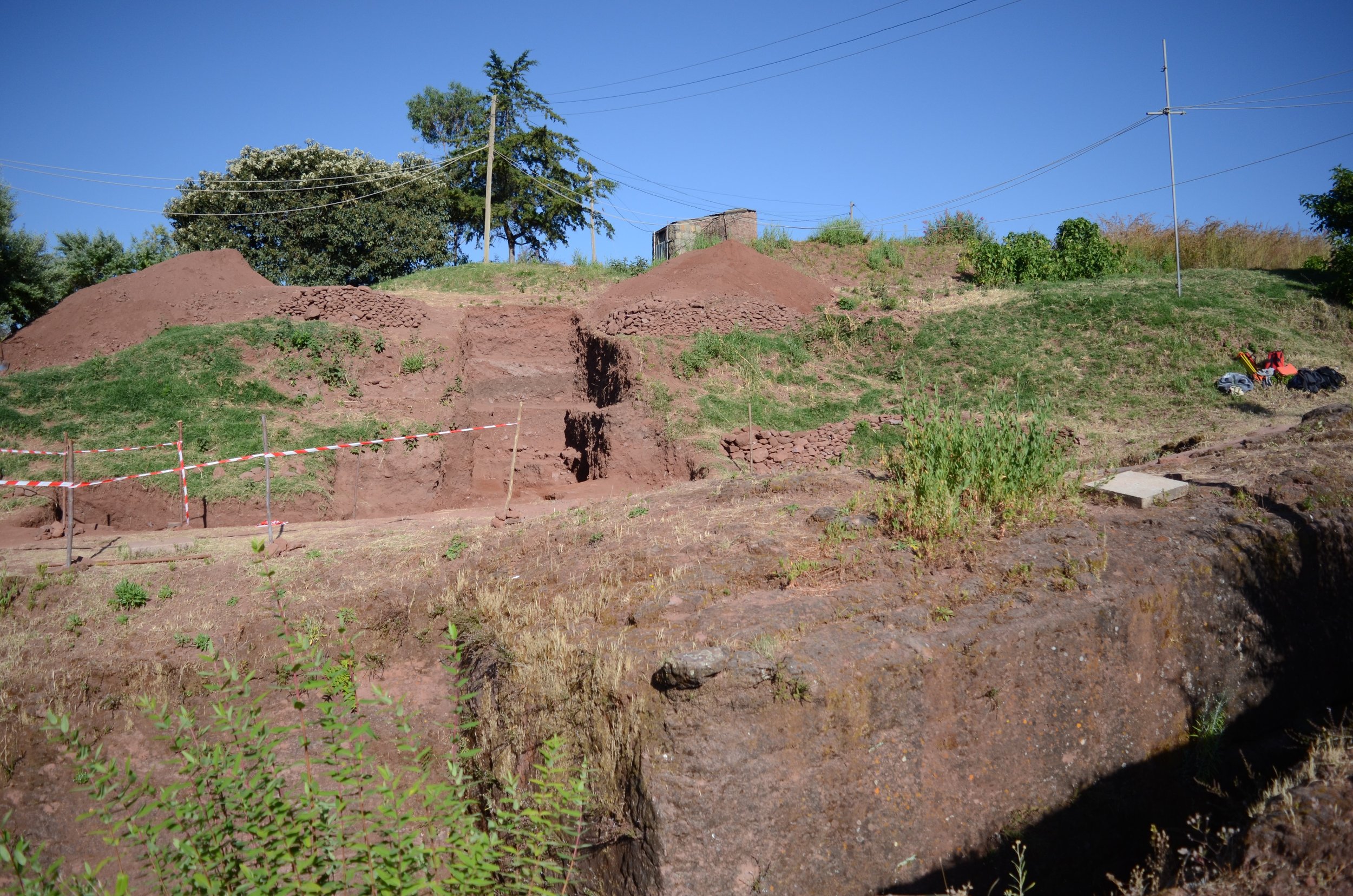
Qeyit Terara and Archaeological Research in Lalibela
Excavating Debris from the Carving of the Churches
The archaeological research conducted in Lalibela has revealed that the excavation of rock to create the monuments, churches, and trenches generated large volumes of debris, with chipped fragments discarded to the sides and forming mounds. Some of these mounds remain in place to this day. After numerous surveys, one of these mounds was selected for archaeological excavation. It is a hill located in the second group of churches, representing, in a way, the negative space of the excavations opposite which it is situated.
The initial archaeological surveys on the periphery of this site uncovered a monumental wall constructed from cut stone, dated using Carbon-14 (C14) to between the mid-10th and mid-11th centuries. (Carbon-14 dating is a scientific method used to determine the age of organic materials by measuring the amount of carbon-14, a radioactive isotope that decays at a constant rate.) Partially collapsed, some sections of this wall are now visible on the path leading to the Gabriel-Rufael church. The excavations then focused on another slope of the hill, facing the Merqorewos church. Starting from the path that connects the various churches in this part of the site, the work involved directly tackling the debris mound. A circular structure, carved into the rock, gradually emerged before the archaeologists' eyes. C14 dating attributed these structures to a period spanning from the mid-11th to the mid-12th century, a few decades before the reign of Lalibela. After obtaining approval from the authorities and residents of Lalibela to leave the excavation site open, the digs were expanded, this time starting from the top of the hill to uncover the different stratigraphic layers.
The archaeological excavation is led by Romain Mensan. Numerous Ethiopian researchers (including Dr. Alebachew Belay and Dr. Hiluf Berhe) and French researchers (Dr. Marie-Laure Derat, Dr. Anne-Lise Goujon, Dr. François-Xavier Fauvelle, Manon Routhiau, Dr. Caroline Robion-Brunner, among others) have participated, along with master’s students from Woldiya University (Lalibela campus) as part of their training in archaeological excavation. The primary result of the excavation is the uncovering of a series of stacked circular structures. These structures attest to the occupation of this part of the site between the mid-11th century and the 18th century, with periods of abandonment in the 14th and 16th centuries. After the 18th century, the entire site was covered by debris. The functions of these structures remain to be clarified. However, each level revealed hearths, remnants of furnishings (primarily ceramic tableware), a few beads, and animal bones. The occupation was therefore not liturgical, but the proximity of these structures to the churches (at least from the 13th century onward) suggests that they played a role associated with the churches and the communities that served them.
Community Archaeology: Co-constructing Historical Narratives from the Archaeological Site
The archaeological excavations in Lalibela were conducted with the consent of the local community and the authorities responsible for protecting this heritage. This consent is not permanent; it depends on the meaning attributed to the site and the role it may play in the future. Discussions are numerous and demanding, leading to the decision to adopt a methodology implemented by Kidane Ayalew: community archaeology. This approach formalizes collaborative efforts with the residents of Lalibela. It primarily involves the workers employed at the archaeological site during the excavations, numbering around 70 individuals, including members of the local clergy, church guards, day laborers of all ages and social backgrounds, and master’s students in archaeology from Woldiya University (Lalibela campus) participating in the excavation as part of their training. They represent a small sample of the diverse local users of Lalibela. Two objectives are pursued. First, to grant a degree of autonomy to the team in its operations by entrusting the management of excavation sectors to students participating in the field school, with a team of workers under their supervision. The involvement of students helps communicate what the archaeologists aim to understand and allows the teams to organize their work as they see fit. Second, through local consultation, to name the archaeological site and thus give it a place in the historical narratives concerning Lalibela.
The consultation to name the site proved to be a particularly powerful tool for engaging in dialogue with the workers and the broader communities of Lalibela. The goal was to revive a toponymy that the life of the churches had tended to erase. Everyone acknowledged that the site had once had a name, but no one could recall it. Through ongoing conversations and discussions, the name eventually resurfaced and was, in a way, approved by the residents and authorities, both religious and heritage-related. The archaeological site is now known as Qeyit Terara. This name refers to a female landowner, Qeyit, who is said to have donated her land to King Lalibela when he sought a space to establish the churches that a celestial revelation had instructed him to build. Terara is the Amharic word for mountain or prominence. Thus, Qeyit Terara means "Qeyit’s Mountain."
Far from being limited to a place name, community archaeology has revived the story of this woman, who embodies the region’s past before the arrival of King Lalibela, just as the archaeological excavations have shed light on occupations predating the reign of this monarch.








